Blog
20 December 2023
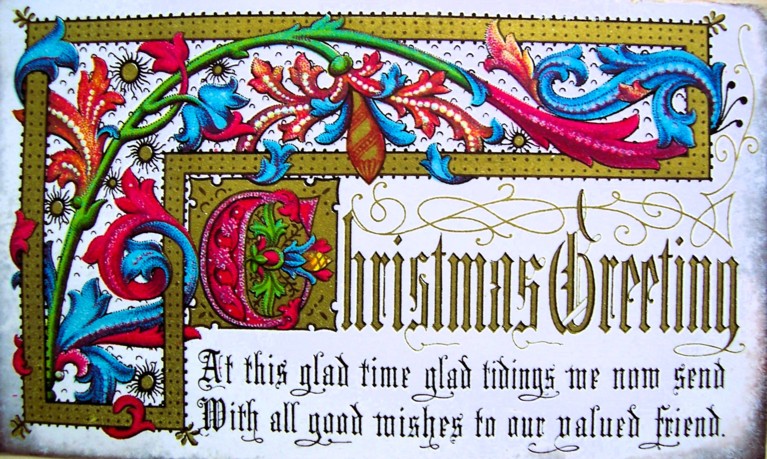
In some fascinating Victorian scrap-books kindly presented to Emmanuel Library by Hugh Pearson (matric. 1987) there are mementos of travels in the form of prints of stately homes (Chatsworth, Goodwood, Lowther, Trentham) and of various foreign resorts (in France, Italy, the Rhine) that have been carefully stuck on to the album pages. There is also a collection of recipes that rather implies the compiler’s single-minded devotion to the traditional British pudding and its tastes and ingredients (with never a mention of chocolate). And there are Christmas and New Year cards, probably from the 1870s onwards, arranged and fastened on the scrapbook pages. All these cards are modest in size (often 10 x 8 cms), on a single flimsy piece of paper: they are not folded cards that stand up. There was a fashion for these greetings to be surrounded by paper borders pierced and patterned to resemble lace.
The familiar iconography of Christmas is already established here. There are snowscapes bristling with holly and holly berries, and robins are ubiquitous and unavoidable.
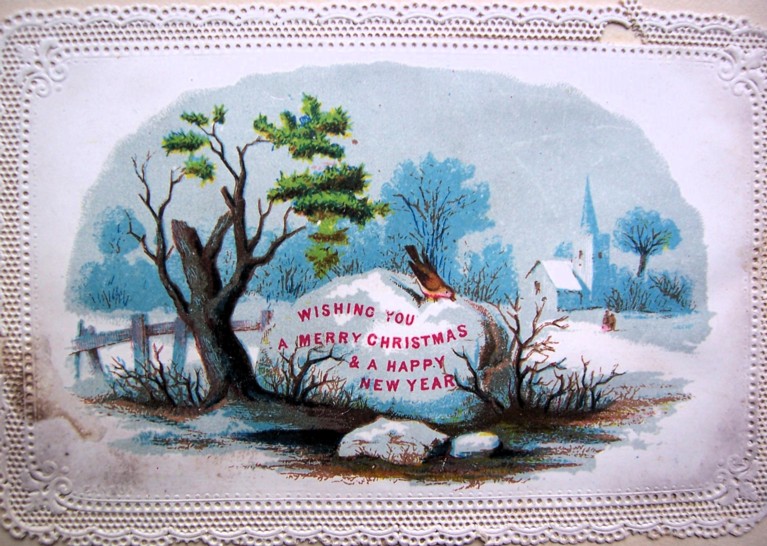
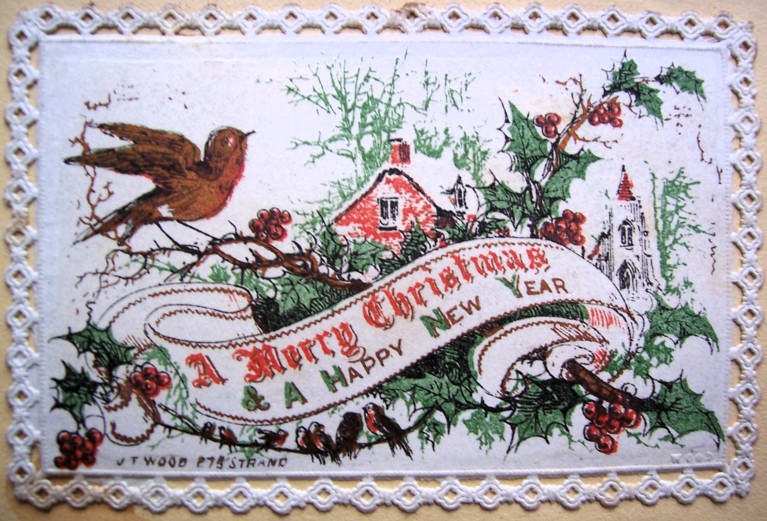
So much of this is still going strong today, and it is usually claimed that it was the Prince Consort who, by introducing various German Christmas customs into the Royal Family’s Christmas, thereby caused those customs to become fashionable, imitated, and duly established in the British Christmas. Those readers of this Victorian scrapbook who enjoyed looking back over the collection of past Christmas cards might also enjoy the ‘Prince Albert Pudding’ for which the album supplies a recipe. Note that, like many of the pudding recipes compiled in the scrapbook, this does entail a serious amount of boiling.
Prince Albert Pudding
½lb (half a pound) of flour; ½lb of butter; beat up well ½lb of loaf sugar sifted, ½lb of raisins chopped fine, 5 eggs, the whites whipped to a stiff froth, a little candied lemon peel.
Steam it 3 hours. Served up with custard sauce.
Some of the Christmas and New Year cards largely consist of some lines of rhymed seasonal greetings, with the text displayed in an ornamental border. The greetings tend to the earnest and uneffusive.
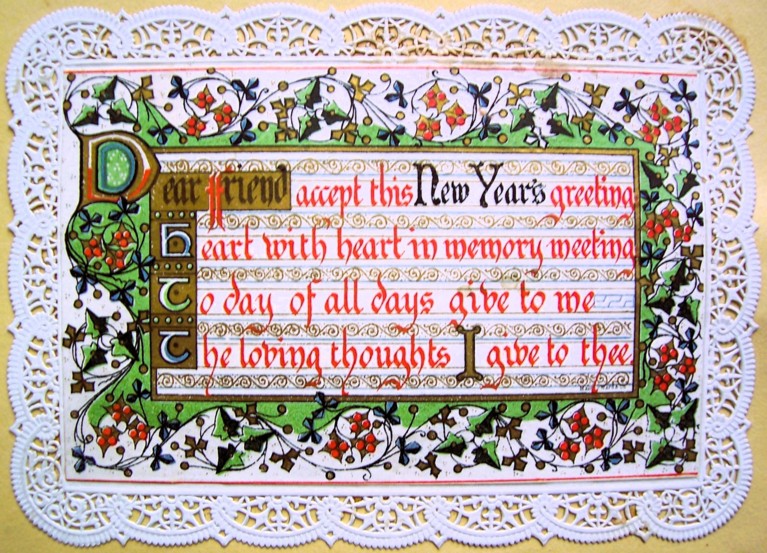
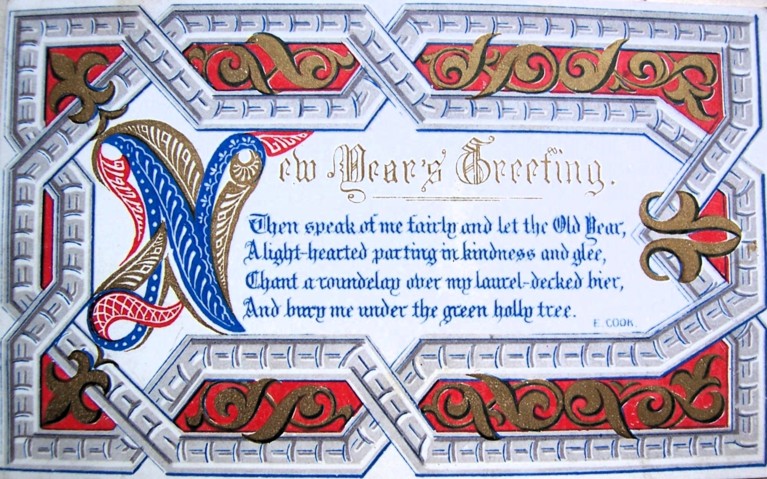
Those high-minded Victorians who sent and appreciated receiving such greetings cards might also appreciate the sobering implications of ‘Half-Pay Pudding’, for which the scrapbook’s recipe rules out all light nonsense but the essentials.
Half-Pay Pudding
¼lb of raisins, ¼lb of currants, ¼lb of chopped suet, ¼lb of flour, ¼lb of breadcrumbs, ¼lb of sugar. Pinch of salt. Without eggs. Boil for 4 hours.
Many cards feature a lift-up flap, where part of the design is hinged to lift up and reveal a Christmas or New Year greeting printed underneath.
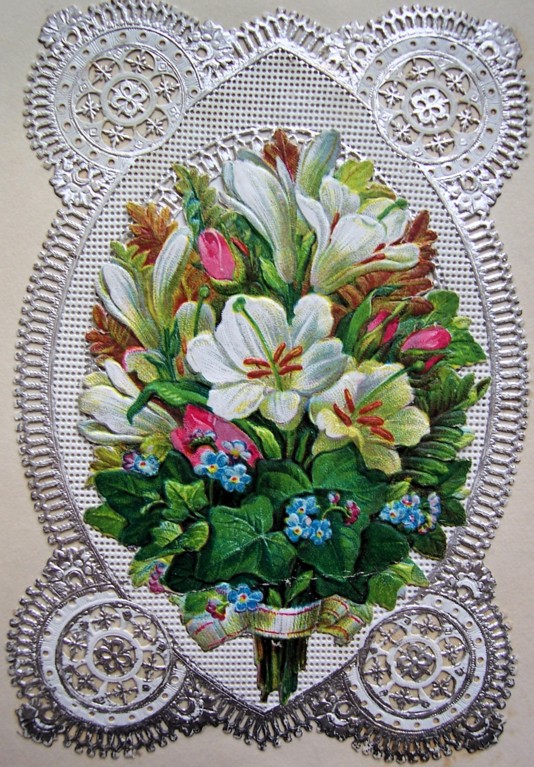
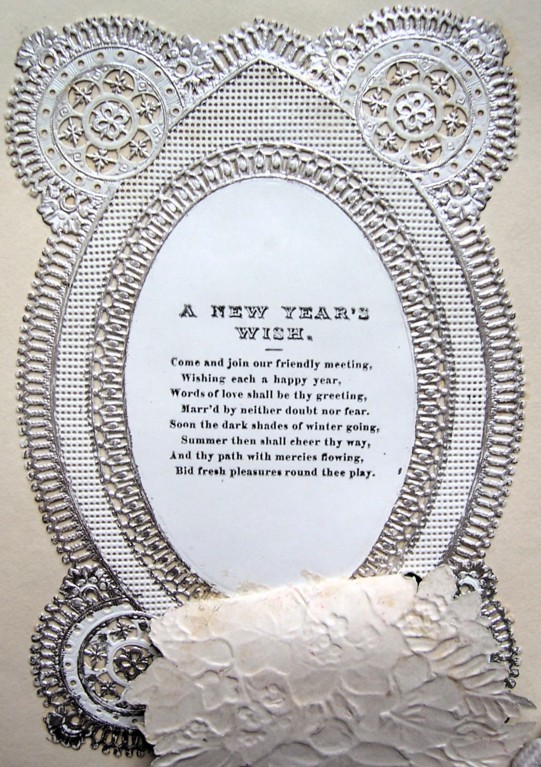
But at least in the selection preserved by this scrapbook, references to the Christian significance of Christmas are understated or absent altogether, and this example is an exception.

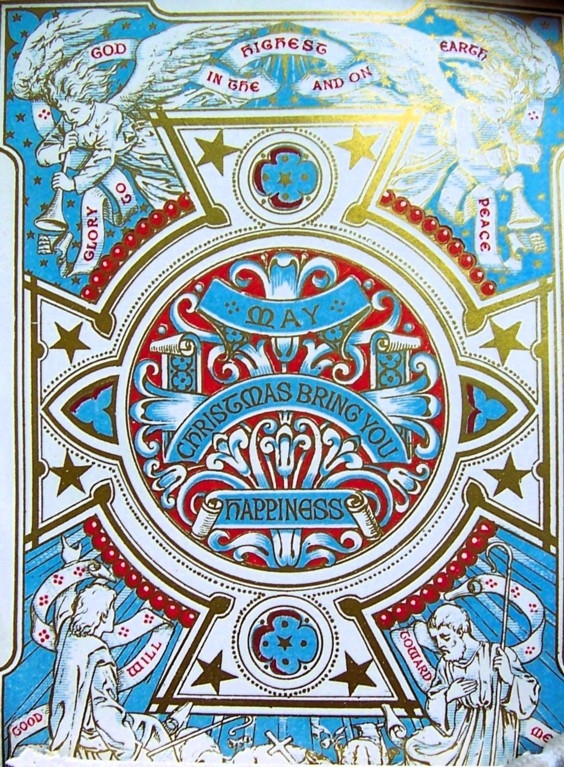
The figure of the evangelist, holding book and quill, lifts up to reveal underneath an intricate design of text and ornament, where the Gospel text of the message from the angels (above) to the shepherds (below) appears in red text on ribbons woven clockwise into the design. The makers of this scrapbook who also preserved a recipe for ‘Paradise Pudding’ seem intent on catering to a more material experience of heavenly sweetness.
Paradise Pudding
Six oz (ounces) of breadcrumbs, six oz of sugar, six oz of currants, six apples grated, six oz of butter beaten to a cream, six eggs, a little lemon peel chopped, and nutmeg.
Boil in a shape, 3 hours. Serve with wine sauce.
As with Christmas cards today, depictions of wintry scenes on Victorian cards are implicitly celebrating Christmas as a refuge and respite from mid-winter cold, as in this sentimental snow-scene of small children warming themselves around a rustic’s blazing fire – a flap is hinged to lift up and reveal a Christmas greeting underneath.
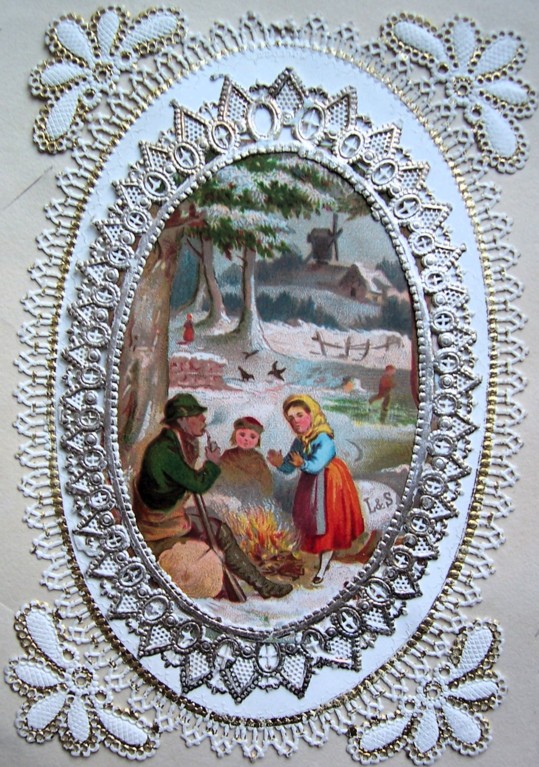
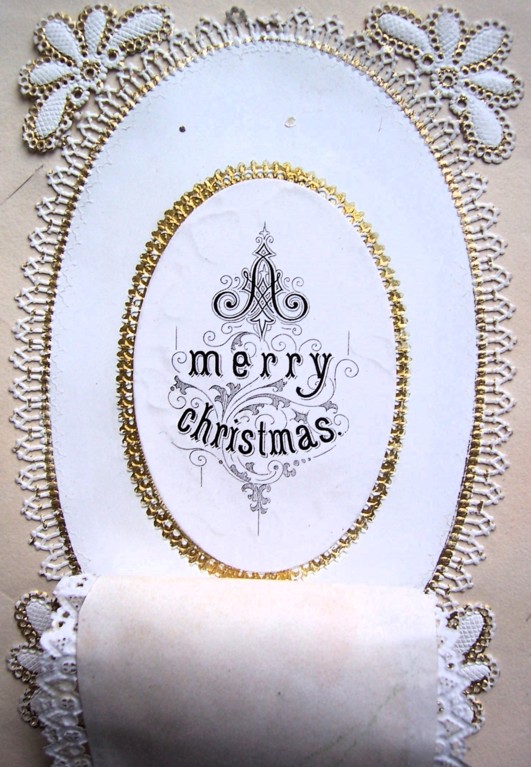
Feasting at mid-winter on rich foods was a traditional defiance of the time of least light, most gloom, and dismal cold. The scrapbook includes no fewer than three different recipes for Christmas pudding, attributed to Mrs Bond, Mrs Fendall, and Mrs Sutton.
Mrs Sutton’s Christmas Pudding 1879
Chop very fine, 1½lb of suet, 2lb of raisins, 1lb of currants; 1lb of flour; ½lb of mixed peel; ½lb of moist sugar; ¼lb of breadcrumbs; 2 Captain biscuits grated; 1 rind of lemon grated; 1 tablespoon of mixed spice; 1 teaspoon of salt; 6 eggs. Mix with ½ pint of milk and a large glass of brandy. Boil for 6 hours.
There are predictably different twists on ingredients and quantities, with Mrs Fendall adding sultanas, chopped apples, orange peel, chopped almonds and making it two glasses of brandy as well as one of sherry. The recipes also differ over their recommended boiling times, which range between five and eight hours.
One curious aspect to us of these Victorian greeting cards is that there are almost as many New Year cards as Christmas cards in the collection – whereas sending a separate New Year card has become rather unusual – and that so many of the cards are not ‘Christmassy’ at all but feature posies of flowers.
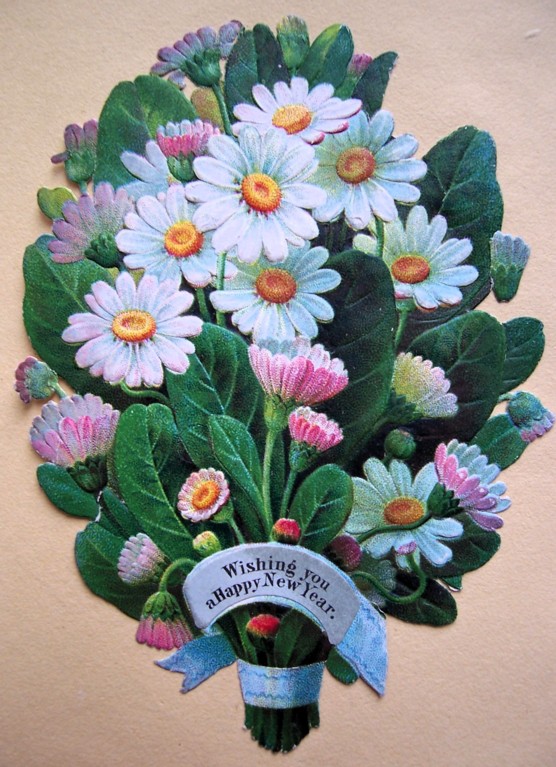
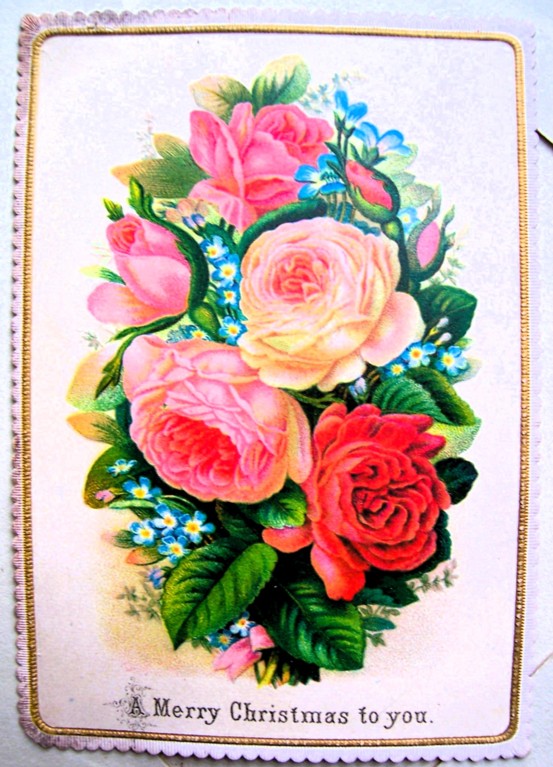
But there was a whole language of meanings expressed through flowers and depictions of flowers, a language now barely remembered. The readers of this scrapbook who enjoyed the sweet confection of ‘Princess Louise Pudding’ would not have been aware of the venturesome extramarital love-life of Queen Victoria’s artist daughter, Princess Louise.
Princess Louise Pudding
1 pint of milk poured over ½ pint of grated bread, the rind of a lemon grated; 3 oz of sugar; the yolks of 2 eggs well beaten. Mix all well & bake in a pie dish for ¾ of an hour, then cover the top with a thin layer of jam. Whisk the whites of the eggs to a stiff froth with 3 oz of powdered loaf sugar, and the juice of ½ the lemon, and put over the jam. Bake 5 minutes.
But they evidently enjoyed the scrapbook page where a rose on a hinged flap lifts up to reveal the ringleted sweetheart underneath.
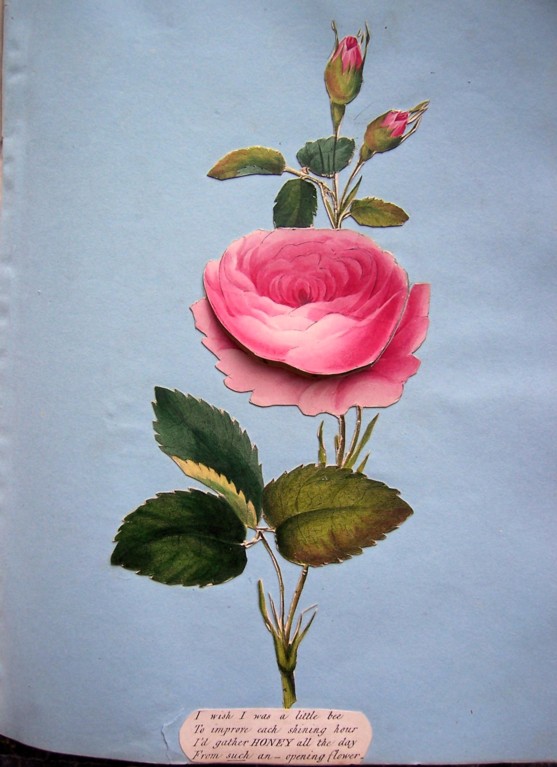
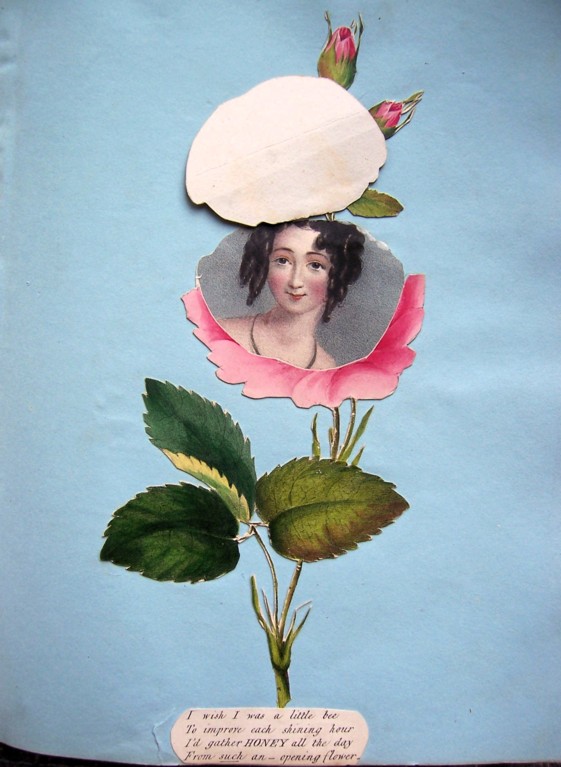
The verse below reads: I wish I were a little bee, | To improve each shining hour. | I’d gather HONEY all the day | From such an … opening flower’.
A merry Christmas and a happy new year to all our readers! Very best wishes also to Dr Helen Carron, who has produced all the images for these blogs since their inception during the first lockdown, and who retires this month as College Librarian after 26 years of devoted service to the College Library and to generations of its student users.
Barry Windeatt, Keeper of Rare Books
